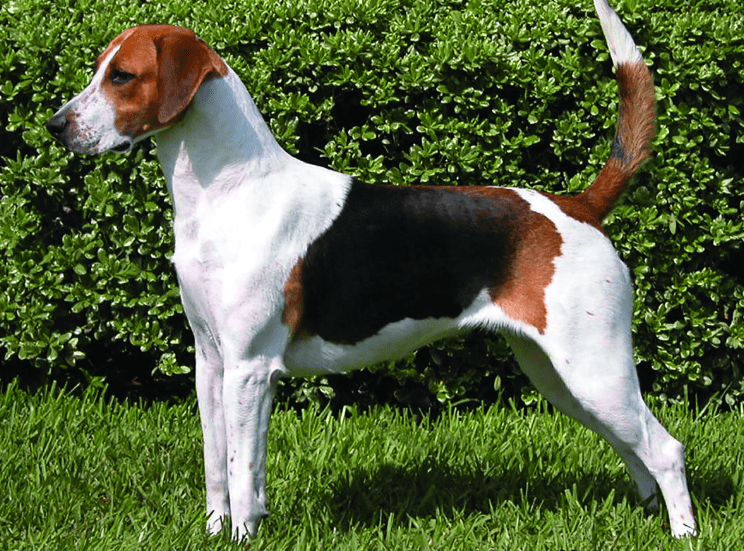
American Foxhounds are friendly, low-maintenance hounds who get along well with children, dogs, and even cats, but they require particular care from potential owners. They have a strong connection to Virginia’s sprawling estates and Revolutionary War heroes. Smooth, rangy American foxhounds are renowned for their speed, stamina, and work ethic. The American Foxhound can be distinguished from its British cousin, the English Foxhound, by the length of its legs, which are longer and more finely boned, as well as by the American’s slightly arched loin (rear end).
American Foxhounds are regarded as having wide, sensitive eyes with a sweet, imploring expression. All is well thus far. Foxhounds, however, require particular care. They must exercise frequently to avoid becoming despondent and destructive. Foxhounds must control their intense prey drive. Training and housebreaking these independent spirits can be a difficult task for inexperienced owners. Their loud crying is musical to hound lovers but can be an annoyance to neighbors.
Care as a Pet/ In Captivity
For this calm but spirited breed to make your life enjoyable, it is essential to comprehend its nature. These dogs are notorious for fiercely following their own desires, which is a quality that makes them excel at pursuing a scent when hunting and they require a lot of activity each day to be fulfilled. Because of its short coat, the American foxhound is simple to groom.

Exercise
Owners need to be aware that these dogs are incredibly energetic and require daily exercise to control undesired behavior. It’s critical to keep in mind that American foxhounds were developed for speed and endurance. They have an apparently endless supply of energy, which necessitates a lot of daily exercise. Be prepared to work out your foxhound for up to two hours each day. The ideal situation is if you have a safe, enclosed space where your dog can run in addition to scheduled training sessions. These dogs enjoy being active, and if they are left home alone, they may turn to destructive behavior to amuse themselves.
The American foxhound, like other scent hounds, has an acute nose and a single-track focus when on the hunt for prey. Due to the increased risk of being hit by a car or becoming lost in the city, you shouldn’t ever trust your foxhound to go off-leash. This dog was bred to disregard everything else around it and follow a scent. This implies that if your foxhound runs off after birds, cars, people, or other animals, it is very unlikely that it will respond to recall commands.
Grooming
Grooming is one area where the foxhound requires very little upkeep. The short, smooth coat of these dogs is close to the body. Although the coarse hair is resistant to matting, it does have a propensity to shed all over the house. To maintain the health of this breed’s coat and minimize shedding, owners should brush it around once per week. When your foxhound’s fur becomes particularly soiled, give it a bath as needed.
Like other dog breeds, foxhounds require routine cleaning of their ears, nail trimming, and tooth brushing. For this breed, it is extremely crucial to check your dog’s ears for debris each week and clean them once a month. Foxhounds are more prone to ear infections due to their floppy ears, which trap moisture. If your dog exhibits symptoms like redness, irritation, swelling, or is frequently shaking its head and pawing at its ears, make an appointment with the vet right once to start treatment. Ear infections can advance rapidly and become excruciatingly painful. Owners of dogs who have had multiple infections should consult a veterinarian to find out how frequently the ears should be cleaned.
Training
The American foxhound’s independence makes it successful in the wild, but it can be problematic in domestic settings. When foxhound puppies are around eight weeks old, you should start putting a high premium on obedience training. Otherwise, you risk having a dog that is resistant to learning the fundamentals of housebreaking or recall commands.
For this breed, positive reinforcement techniques work well. To keep the dog interested, training sessions should be brief and repeated frequently. If training gets monotonous, the dog is likely to walk off. Avoid using any punishment-based strategies; they frequently have the opposite effect. Foxhounds have extremely sensitive personalities, so if their owners yell at them, they may start to dread them and become less inclined to follow their instructions.
Diet and Nutrition
Like all dogs, the American foxhound thrives when fed premium dog chow, either store-bought or homemade under your veterinarian’s supervision. Remember that these energetic dogs will need a protein-rich food source; therefore formulations with a lot of filler should be avoided. Given that these dogs are motivated by food and are likely to overeat given the chance, it is better to limit the amount of healthful treats you give them.
Give your American foxhound two meals that are measured out each day. Ask your veterinarian to help you set a balanced meal and portion schedule based on your particular dog’s age, weight, and activity level if you’re unsure how much food they should be eating.
Table





